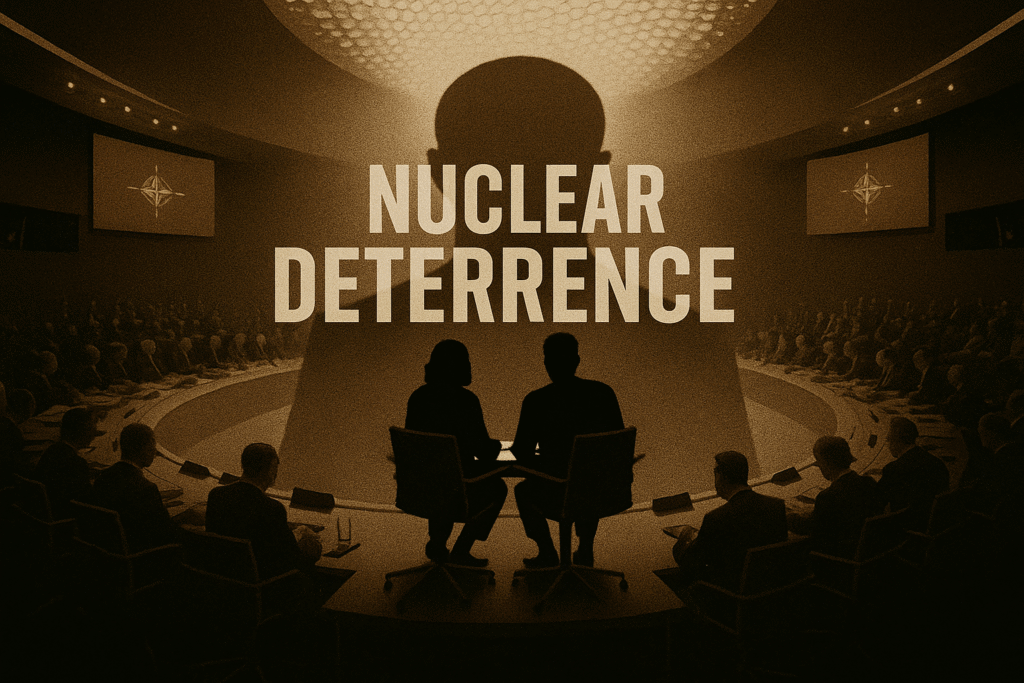A Fading Shield: Rethinking Deterrence in a Fractured World
Since the nuclear age began, global security has rested on a grim logic: the threat of mutual destruction would deter war. The doctrine of mutually assured destruction (MAD) was never about idealism; it relied on the notion that if nobody could win a nuclear exchange, nobody would dare start one.
This idea shaped Cold War strategies. Nuclear weapons, though terrifying, were seen as guardians of peace. Some even argued their spread might stabilise certain regions. But this logic is eroding.

Today’s world is far removed from the structured bipolarity of the Cold War. Ukraine has struck Russian airbases hosting nuclear-capable bombers. Iran has turned away from nuclear diplomacy. China has showcased missiles with an intercontinental range. These are not isolated acts; they are signs of a system under strain.
This article contends that while deterrence remains foundational to nuclear strategy, its practical relevance is rapidly diminishing. Nuclear arms have evolved from passive shields to active tools of leverage. The assumption that mere possession deters use, a view long endorsed by Kenneth Waltz, is losing ground in a world shaped by asymmetry, regional rivalry, and blurred lines.
As international institutions struggle and regional actors grow more aggressive, deterrence risks becoming an excuse for brinkmanship. Can MAD still work in an age of cyber threats, proxy wars, and ideological regimes? Do our current arms control frameworks address modern threats? Most crucially, is it time to redefine nuclear responsibility, not only in terms of power, but as a matter of restraint, shared risk, and collective accountability?
Classical Deterrence: MAD, ODB, and Strategic Assumptions
Deterrence theory is rooted in the belief that rational states avoid self-destruction. MAD relies on this premise: that a nuclear first strike would trigger devastating retaliation, thus deterring all sides from acting.
This idea fits within the Offensive-Defensive Balance (ODB). Shiping Tang explains that when offence dominates, defence becomes futile, making deterrence the only stabiliser. Nuclear arms, then, are meant to prevent rather than fight wars.
Yet this framework is built on fragile assumptions: that all actors are rational, that communication is clear, and that survival is universally prioritised. While the Cold War avoided full-scale nuclear war, it did so more through fortune and diplomacy than perfect logic.
Critics question whether deterrence truly holds when states are ideologically driven or lack institutional checks. Asymmetric situations, like Israel’s nuclear monopoly in the Middle East, test the theory’s limits.
New technologies like cyber tools and hypersonic missiles further disrupt this calculus. Deterrence was designed for binary, state-centric conflicts. Today’s threats are more varied and less predictable.
Strategic Asymmetry: Iran, Israel, and the Middle East
The Middle East underscores the cracks in deterrence theory. Israel’s nuclear monopoly and Iran’s aspirations have created an unstable imbalance, not the mutual restraint envisioned by MAD.
Kenneth Waltz’s argument that a nuclear-armed Iran could stabilise the region was provocative but grounded in logic. Tehran’s pursuit of deterrence may reflect strategic necessity, not recklessness.
Historical precedent supports this view. Israel has pre-emptively struck Iraq and Syria to preserve its nuclear edge. The possibility of doing the same to Iran persists. But monopolies provoke insecurity and encourage others to catch up.
Iran, shaped by historical trauma and surrounded by threats, sees nuclear capability as a survival tool. Its persistence despite sabotage and sanctions reflects a long-term strategic calculus.
While critics depict Iran as irrational, history shows that nuclear states from Mao’s China to India tend to grow more cautious. Proliferation in the region remains slow due to cost, complexity, and global scrutiny.
Still, asymmetric deterrence is dangerous. It encourages paranoia, preemption, and proxy conflict. Long-term stability requires not just parity but diplomacy, oversight, and mutual respect.
New Cold Fronts: Eroding Stability in a Multipolar World
Deterrence once offered clarity. Now, in a fragmented world, it struggles to keep up. Nuclear weapons are no longer just deterrents, they’re part of active strategic posturing.
Ukraine’s drone strike on a Russian nuclear bomber base shook long-held assumptions. Sites once thought invulnerable are now targets. Russia’s reaction highlights the volatility of nuclear signalling.
China’s unveiling of the DF-5B ICBM, capable of reaching the U.S. and Europe, was symbolic, not aggressive. It reflects a shift in how deterrence is communicated. China still claims a defensive posture, but the emphasis on visibility and reach is telling.
Meanwhile, Iran’s rejection of renewed nuclear talks and the decay of the JCPOA show a broader failure of arms control. The NPT and CTBT, once mainstays of non-proliferation, now seem ill-equipped for today’s dynamics.
Even close allies are uneasy. Australian Defence Minister Richard Marles recently warned of growing proliferation risks, not only from rogue states, but due to treaty erosion and strategic ambiguity. Rather than restraining behaviour, deterrence enables risky gambles under the illusion of stability.
Today, the credibility of nuclear deterrence is muddled by conventional wars, cyber threats, and blurred thresholds. The Cold War’s clear red lines are gone. Miscalculation is easier and far more dangerous.
Fragile Assumptions: Human Fallibility and Escalation Risks
Deterrence theory relies on rationality. Reality does not. Leaders misjudge. Institutions fail. Pride, ideology, and fear override logic.
Near-misses like the Cuban Missile Crisis or Cold War radar errors remind us that luck and restraint doctrine have often prevented catastrophe. Modern risks are even higher. Cyberattacks, autonomous systems, and compressed decision timelines mean less room for error.
Some nuclear powers maintain robust civilian control. Others, especially in authoritarian states, may not. When decisions lie with a few individuals, the risks multiply.
Regional flashpoints add instability. Kashmir, Taiwan, and the Korean Peninsula are all potential spark points where local events could escalate dangerously. Non-state actors and proxy wars further erode predictability.
Shiping Tang reminds us that judgment, not just capability, drives war. The Chekhovian principle applies: weapons made ready may eventually be used. The greatest danger lies in believing rationality will always prevail.
Conclusion: Beyond Deterrence, Toward Shared Responsibility
The nuclear doctrines of the 20th century are struggling in the 21st century. MAD worked in theory, but today’s threats, actors, and technologies demand more than inherited logic.
The Middle East shows how imbalance fosters insecurity. Waltz’s argument for a nuclear Iran, while controversial, underscores a more profound truth: Monopolies invite resistance.
In Eastern Europe and the Indo-Pacific, deterrence is no longer passive. China’s signals and Russia’s threats place nuclear weapons at the heart of geopolitical narratives.
But the most significant variable remains human. As technology accelerates, the margin for error narrows. Deterrence has often worked by chance, we cannot rely on chance forever.
The path forward isn’t blind disarmament or uncritical deterrence. It’s a new strategic ethic; transparent, collaborative, and grounded in humility. Arms control, regional dialogue, and civil oversight are no longer optional, they are essential.
True strategic maturity lies not in managing terror’s balance, but in outgrowing it.
Bibliography
Tang, Shiping. A Theory of Security Strategy for Our Time: Defensive Realism. New York: Palgrave Macmillan, 2010.
Waltz, Kenneth N. “Why Iran Should Get the Bomb.” Foreign Affairs 91, no. 4 (2012): 2–5.
Marles, Richard. Speech, Australian Strategic Policy Institute, Canberra, March 15, 2024.
Comprehensive Nuclear-Test-Ban Treaty (CTBT). United Nations Office for Disarmament Affairs. https://www.ctbto.org/.
Joint Comprehensive Plan of Action (JCPOA). U.S. State Department Archive. https://2009-2017.state.gov/e/eb/tfs/spi/iran/jcpoa/.
Oppenheimer, J. Robert. “Letter to President Truman,” October 25, 1945. U.S. National Archives.

